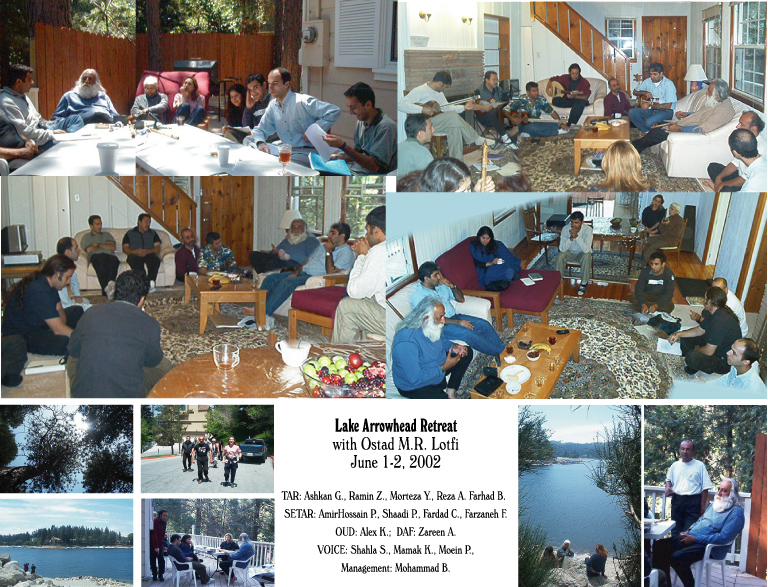
This is a report of Ostad Lotfi's June 2002 trip to San Diego.
Ostad Lotfi had a concert and held classes in San Diego last year. The 2001 report is available here.
This year in addition to classes, we also had a 2-day
seminar in Lake Arrowhead.
Due to limited time and the focus on instruction, this year there was no concert.
Our teamwork was better than last year, but still needs work.
Future plans, Responsibilities,
Actions.
Many thanks to Ostad Lotfi for his time and patience, Ramin and Ashkan for their help in planning and traveling down here from the Bay Area, Parvin for traveling from Virginia to strengthen Shayda, Yasi & Farzaneh & Katayoun for all their help, Moin for the beautiful cabin, Houshang for Mr. Lotfi's lodging and furniture, and Moein & Mohammad & myself (Farhad) for making this trip possible!
If you would like to comment please email me.
11 students - including 3 from Irvine
and 2 from the Bay Area - studied with Ostad for a total of 40 hours.
Additionally there was a beginning setar class and a beginning tar class.
15 of us spent 1 night and 2 days at a cabin in Lake Arrowhead. The plan was to be there Friday night, but a wild fire prevented us from going until Saturday morning.
Saturday afternoon and Sunday morning were spent in lectures
on aspects of Persian music.
Saturday night Ostad played a wonderfully sonorous Dashti solo on tar (accompanied in parts by Zarrin on daf) which ended perfectly abruptly when the bridge collapsed!
Sunday evening Ostad played an interesting Mahur on setar, in which he went to Delkesh (Shur) and from there to Esfahan! Later he mentioned this had been first done by Zarpanjeh (early 20th century tar master).
Each evening Ostad directed students in music-making. On Sunday, after all tuning to Mahur, Ostad instructed us to 1) listen carefully to each other (while gently strumming the open chord) and then 2) each play a phrase or two 'when the music came to you'. This created a nice atmosphere for making music, but we have to practice it to feel more comfortable doing it.

More pictures 1 2 3 4 5 6 7 8 9 10 11
Form a group (Shayda) in San Diego dedicated to promoting classical
Persian Music. Work with other groups (e.g. PCC, Zaman, Darvak, ...) to achieve
goals. Core group meet monthly to plan activities.
Strategies
Alex (research, lectures, university contact), Moein (logistics), Mohammad
(concerts, finances), Farhad (education, overall coordination), Morteza (tar,
Irvine), AmirHosein (setar, L.A.).
Each responsibility area can have it's own team utilizing students from San
Diego, Irvine, and L.A.
Next year plan classes in the last half of May, coordinate with Dr. Peterman's World Music seminar (1st week of June), and organize a public concert towards the end of the seminar so that participants can attend.
On Saturday, Ostad presented us a few topics to choose from:
We were interested in all the topics!
A summary follows:
Up to about 100 years ago, theory and practice of Persian Music were separate: players did not have to know theory and theoreticians did not play. It is only recently that musicians are trying to formulate theory based on analysis of radifs and old texts (e.g. borhaan-e alhaan).
Radif is the grammar of Persian Music.
"Radif is the serial ordering of gusheh" although correct, is not
a complete definition.
Radif is based on overlapping tetrachords ("daang").
| 1 | 2 | 3 | 4 | |||
| 1 | 2 | 3 | 4 |
Each tetrachord can hold several gusheh. Consider that Razavi and Gharacheh
(in dastgah Shur) are in a high tetrachord, but have been transposed down an
octave due to vocal limitations.
Each dastgah has it's own radif, which can encompass 2 full octaves.
Each dastgah has a main way "(raah") through the various gusheh and
other secondary ways.
e.g. in Mahur (C D E F), the main way would be (F G A
Bb) and a secondary way (F G Ap Bb).
Each dastgah starts on the 0th (zero) note (usually an open string) except
Segah.
Each fret ("pardeh") has a name.
e.g. shur, rohab, sarang, salmak, dashti, mahur, razavi or gharache
e.g. mahur, daad, dashti, hesar, feili or delkesh, khaavaraan, neishaburak or
tarabangiz
Shur is the mother of all dastgah since all others can be derived from it:
e.g. Mahur inside of Shur| G | AP | Bb | C | D | Eb | F | G |
| Mahur | |||||||
On Sunday the topic of discussion was "aan" (the present moment).
Iranian people connect with music thru melody. Simple, original melodies are often the most haunting.
How to create beautiful melodies? By being there in the present moment ("aan"). Knowledge increases the depth of the "aan" but is secondary to it. Having "it" means increased sensitivity, concentrating on the moment, and feeling everything deeply.
The same old melody (e.g. kereshmeh) played with "aan" can affect you deeply - even when technique is weak.
How to get "aan"? By spending time with people who have it. You don't have to ask questions, since it cannot be taught, but can be felt.
How to get knowledge? Find a good teacher. The first step is your desire (talab)
to learn.
Shams said: "Keep what warms you, but discard what makes you cold".